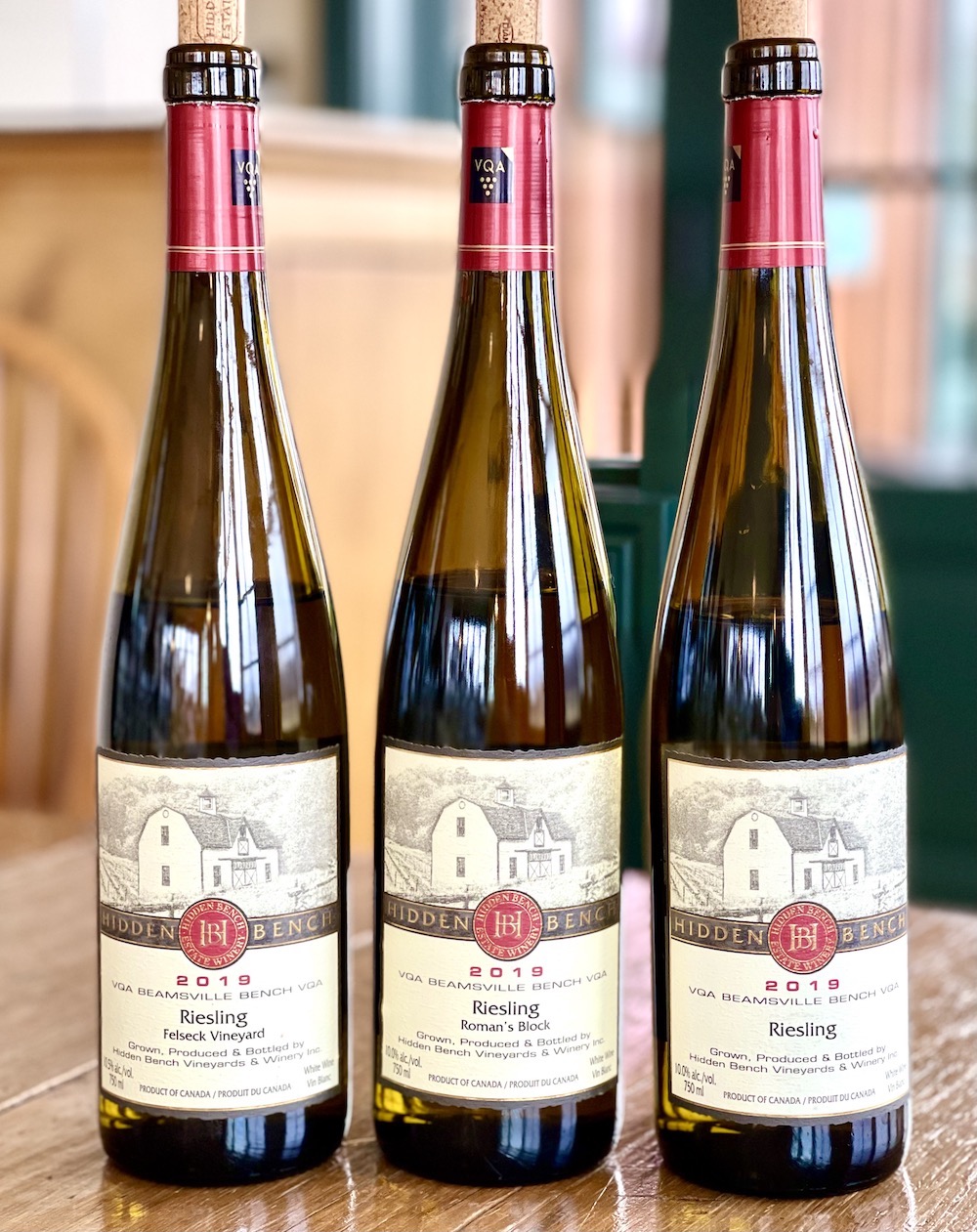By Rick VanSickle
A common axiom wine growers in Niagara believe in is that there is no predicting a vintage until you get at least to the Labour Day weekend.
Well, after a wet and rather dismal August (for winemakers, campers, outdoor enthusiasts, patio lovers and, well, everyone) the beginning of September could be just what the doctor ordered. A heat spike with just enough bright sunshine to burn off most of the humidity in the vineyard is giving renewed hope for a vintage that started off perfectly but had some mid-summer hiccups.

“It’s been a demanding summer for sure,” said Vineland Estates winemaker Brian Schmidt, “but I feel really good about where we are now. In in my experience autumn will make or break us … time will tell.”
Some are comparing the 2023 vintage (before the heat Labour Day heat wave) to 2008 or even the 1997 vintage when the summer was “dull and cool, but everything changed on the Labour Day weekend,” recalled Southbrook owner Bill Redelmeier. “It turned into a great vintage, especially the whites.”
It’s early days for most of the varieties hanging out there, some just out of veraison recently, and there are many hurdles yet to overcome to determine the quality of wines that will come from the 2023 vintage, but spirits are a lot brighter with the good start to harvest season.

A quick jaunt through a couple of vineyards on the weekend, namely Le Clos Jordanne, Wismer-Foxcroft and St. Urban, revealed plump and juicy grapes with little degradation and even ripening. The first harvest I know of was at Featherstone Estate Winery with an early Pinot Noir pick for sparkling wine.
Ravine Vineyard winemaker Lydia Tomek told Wines in Niagara she plans on picking sparkling grapes Thursday, while Schmidt plans on harvesting a small amount of Regent on Thursday, as well.
Coinciding with harvest season in Ontario, the Sept. 9 (Saturday) Vintages release is chock-full of great Niagara wines from rock star terroirs mostly from the Twenty Mile and Beamsville Bench. We review some of the standouts including Vineland Estate St. Urban Vineyard Riesling, Cloudsley Cellars Twenty Mile Bench Pinot Noir, Hidden Bench Estate Riesling, Divergence Gamay Noir, Le Clos Jordanne Jordan Village Pinot Noir, plus a beauty in the September Cellar Collection (ordering on Thursday) from Bachelder Wines, the Wismer-Parke Pinot Noir 2020.
Also in this report: A cool new ancestral style wine from Stratus Vineyards and new wines from Henry of Pelham. So, let’s get this show on the road!
Welcome to the world, Stratus Ancestral!

Here’s the scenario: Take Cabernet Franc, Cabernet Sauvignon, Gamay, Merlot, Petit Verdot, Sangiovese, Syrah, Tannat, Tempranillo, Malbec, Chardonnay, Gewürztraminer, Riesling, Sauvignon Blanc, Sémillon, don’t forget the Viognier, then pick all the grapes at same time, crush them at the same time and co-ferment the whole lot. The result? Stratus Vineyards’ Ancestral Field Blend Rosé 2022.
“It’s very much the “Dom Pérignon” mindset,” explained Stratus winemaker Dean Stoyka, above photo. “That is, 16 different varieties at all different maturities will make a wine that is balanced in maturity.”
Stoyka told Wines in Niagara that a substantial amount of the Stratus Vineyard is planted to a field blend, with 45 blocks on only 56 acres with some rows having up to four varieties in one row.
To be called a “field blend” in Ontario requires that each variety picked must be accounted for. It’s a challenge to keep track with so “many different unknown varieties planted in the same vineyard in unknown locations. “So, we have what can be as close to a field blend as possible with our regulations,” said Stoyka.
The wine is made under the “Trials” tier, where the winemakers play with ideas at harvest and experiment with fermentation techniques, varietal blends, and ageing vessels. If an idea shows promise, it is made under the “Trial” series label for consumers to enjoy and experience the outer boundaries of Stratus’s ever-evolving portfolio.
These wines are made in small quantities (only 40 cases of the Ancestral was made) and usually sell out quickly.

Stratus Vineyards Ancestral Field Blend Rosé 2022 ($35, still some available at Stratus as of this writing) — As mentioned above, 16 grape varieties of estate fruit are picked at the same time, crushed at the same time and fermented at the same time. It’s made in the ancestral style, also known at pét-nat where the first fermentation stops in the vat and the second fermentation happens in the bottle and is finished with less than 2 g/l of residual sugar and 13% abv. I opened my provided sample dock side in Muskoka with friends and it poured a cloudy pale salmon colour in the glass with soft effervescence. There is a cacophony of aromas that waft from the glass: apricot, watermelon, white peach, bruised apple, earthy/savoury notes, grapefruit, and herbs. The subtle tickle of bubbles on the palate lifts the ample range of tart orchard fruits, tangy citrus, pomegranate, and savoury herbs, with a subtle hint of tannins, a creamy texture and electric acidity keeping it lively and clean through the finish. This is a cool wine for the more adventurist wine lovers out there who appreciate this edgy style of winemaking.
Our picks of the Niagara wines coming to Vintages Saturday

Vineland Estate Elevation St. Urban Vineyard Riesling 2022 ($23, new review, 93 points) — The historic St. Urban Vineyard was planted in 1979 and has consistently made some of most minerally-specific Rieslings in the country. Winemaker Brian Schmidt used St. Urban Vineyard Field D for this wine. The Elevation Riesling is now the top seller at Twenty Mile Bench winery, surpassing only recently the Semi-Dry Riesling. I originally tentatively reviewed this wine a year ago but have added new notes after re-tasting the wine last week. The Elevation Riesling is finished with 28 g/l of RS. This follows closely to previous versions with a pretty and profound nose of fresh-squeezed lime, wet stones and saline minerality, green apple, apricots, lemon blossoms, and pear. It has lovely texture on the palate with intensity and verve to go with a mélange of lime/citrus, ripe pear, a hint of honey, subtle peach notes, stony minerality, ginger and electric acidity driving the back end and keeping everything in balance. These Elevation Rieslings have a sound history of aging beautifully for 10 years plus. Great value from a top-notch Niagara Riesling from the Twenty Mile Bench. Load up!

Cloudsley Cellars Twenty Mile Bench Pinot Noir 2019 ($35, new review, 91 points) — Cloudsley has established itself among the “terroir-centric” wineries on the Twenty Mile Bench specializing in Pinot Noir and Chardonnay. This Pinot is from a blend of vineyards on the Bench and shows a lighter shade of red in the glass with a subtle reductive note before the perfumy floral notes kick in followed by red cherries, undergrowth, black raspberries, touch of anise, herbs, and integrated oak spices. It’s mouth-coating and shows more precision on the palate with tart cherries, brambly raspberries, violets, chalky tannins, sizzling acidity, and a spicy bump on the lifted finish. This is an interesting Pinot Noir, but I would wait on it for a year or two and it can be cellared 5+ years.

Hidden Bench Estate Riesling 2019 ($25, 92 points) — The estate version of this Riesling is a blend of the three Hidden Bench vineyards — Locust Lane, Felseck and Rosomel. This is a pure and fresh Riesling with a floral nose that displays honeysuckle, lime, grapefruit, apple skin, stony minerality and saline freshness. There is sweet-tart tension on the palate with gushing lemon, green apple, pear and stony minerality in a focused and racy style that all leads to a bright, lifted finish. Can cellar to 2027.

Divergence Gamay Noir 2021 ($28, 91 points) — This Gamay is sourced from the Wismer Wingfield Vineyard on the Twenty Mile Bench. It spends 14 days on the skins before being sent to older oak barrels for nine months of aging. It needed a decant when first reviewed, but after doing that and swirling vigorously the nose revealed plums, brambly black raspberries, macerated cherries, earthy notes and just a touch of spice. It’s smooth and textured on the palate with rich and savoury red berries, plums, anise, spices, and plenty of zip on the finish. Should be drinking nicely right about now.

Le Clos Jordanne Jordan Village Pinot Noir 2020 ($30, 91 points) — The Village Pinot has a perfumed nose with earthy/savoury notes, red currants, delicate spice notes, wild red berries, and a touch of cassis. It’s rich, savoury, and generous on the palate with dark cherries, black currants, wild blackberries, silky tannins and elegant spice notes. The finish is long and lifted. Can cellar to 2026.

Henry of Pelham Special Late Harvest Vidal 2019 ($20 for 375 mL, new review, 92 points) — What a lovely late harvest Vidal with a nose of apricot tart, sweet nectarine, summer peaches, marmalade, and ginger notes. It’s quite lush and unctuous on the palate with a silky texture to go with compoted orchard fruits, candied citrus, apricots, and ginger notes with plenty of juicy acidity to give it some balance on the finish. Great (inexpensive) alternative to icewine.

Featherstone Rosé 2022 ($17, 90 points) — This is a blend of Cabernet Sauvignon, Cabernet Franc, Gamay, and Pinot Noir and shows a colour in the glass described by proprietor Louise Engel as “hot-pants pink.” It’s no secret Featherstone prefers a bolder style of rosé, and this follows that path with a juicy nose of summer strawberries, wild raspberries, plums, cranberries and underlying earthy notes. It’s flavour-packed on the palate with red berries, plums, earthy/savoury notes and a bright, lifted finish. Delicious!
Also released, but not reviewed by Wines in Niagara:
• Kew Vineyards Chardonnay Cuvée Sparkling 2016 ($24)
• 13th Street June’s Vineyard Riesling 2021 ($22)
• Locust Lane Chardonnay 2019 ($25)
• Red Tractor Chardonnay 2021 ($18)
• Cave Spring Estate Grown Cabernet Franc 2021 ($21)
• Speck Brothers Family Tree The Boxer’s Ghost Pinot Noir 2022 ($20)
• Bachelder the lone Canadian wine in the Vintages “Cellar” release
A Niagara treat from the Cellar Collection
Ordering for September’s monthly Cellar Collection begins Thursday (Sept. 7) at 8:30 a.m. There’s only one Canadian wine in the release, but it’s a dandy.

Bachelder Wismer-Parke Pinot Noir 2020 $55, 92 points) — Wismer-Parke is 5.5 km from the lake at an altitude of 133 metres, from the sweet spot on the Twenty Mile Bench on reddish magnesium and dolomitic-limestone clay soils with a solid silt component. The vines were planted in 1999. When first tasted, this was a bit shy on the nose now but opened up to wild red berries, a touch of black currants and anise with lovely floral and spice notes. It shows a bit of muscle on the palate with darker berries, firm(ish) tannins (the classic iron fist in a velvet glove), underbrush, savoury spice notes and finesse through the long finish. Might need a little time to open up or decant if you cannot wait. Can cellar to 2028.
New wines from Henry of Pelham

Henry of Pelham The Shadow Rock Sauvignon Blanc 2021 ($22, 88 points) — the nose displays rich tropical fruits, ripe pear, light herbs, grapefruit and lingering spice notes with some oak aging. It’s quite concentrated on the palate with kiwi, passion fruit, pineapple/mango, herbs, grassy notes, subtle spice notes and a rounded finish.

Henry of Pelham The Padré Cabernet Merlot 2020 ($18, 89 points) — Gotta love the gift that keeps on giving from the 2020 vintage. This smartly priced Cabernet/Merlot blend shows a ripe nose of brambly raspberries, plums, dark cherries, anise, mulled herbs, and spice notes. The palate is a mélange of red and dark fruits, sweet cedar notes, forest floor, herbs, anise/licorice, and layers of spice on a firm bed of tannins and a bright finish. Bring on the red meat!







Comment here